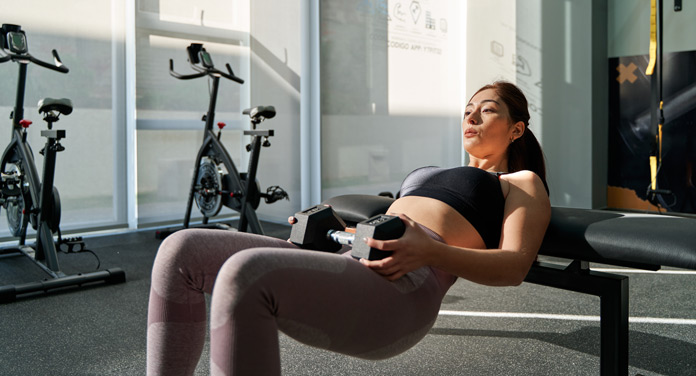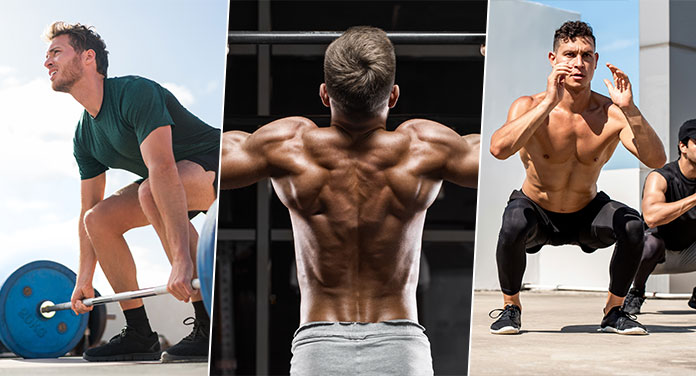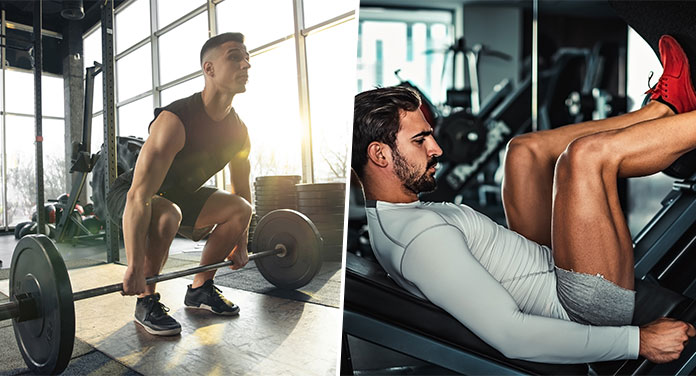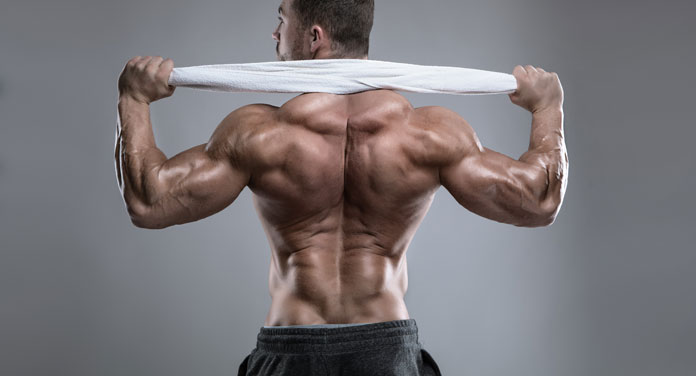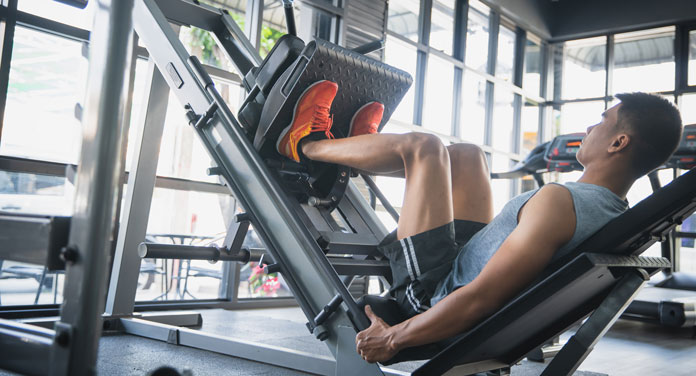Hip Thrust Exercise – Probably the most popular exercise to train the glutes is the hip thrust. You can find out from us what it is and what makes the hip thrust so effective.
What Is The Hip Thrust?
The exercise is designed to work the buttocks and hamstrings without putting too much strain on your knees or straining your front thighs.
Also, this exercise is super easy to do. The shoulder blades should be placed at an elevation to increase the range of motion. The feet remain on the ground. When you have reached the starting position, you now push your hips towards the ceiling. As a result, your glutes are trained to their full range of motion. It sounds simple, and it is!
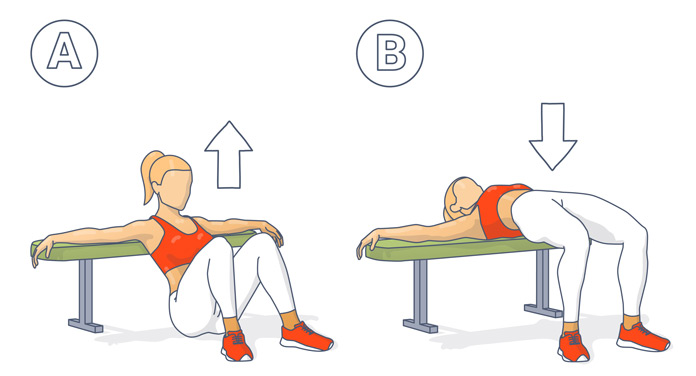
As a tip we give you something on top of that: In addition to strengthening your buttock muscles, it is also important to eat the right food. For optimal strength training, we recommend that you consume at least 1.5 to 2 g protein/lbs body weight.
This is how you promote your muscle growth. Now you’re probably thinking: How on earth am I supposed to eat that much protein? There are different protein shakes from different manufacturers. Most will give you around 23g of protein per serving. However, the shakes are great for in-between or directly at the end of the training session.
There are many exercises for a firm bottom, but none is as popular as the hip thrust. Even professionals and bodybuilders like to do this exercise. Sure, who wouldn’t want a firm butt? But where does this exercise actually come from?
The Origin of the Hip Thrust
On a late October evening, a Ph.D. in sports science and personal trainer was watching UFC fights on TV with his girlfriend. Here, a fighter was thrown to the ground and held by the opponent. The sports scientist began to think about how one could free oneself from lying on the ground here. If the one on the ground bridged and hips up, he could either throw his opponent off or crawl out from under him. And that’s where the hip thrusts came from. Increasing the range of motion and stretching the hips against a load is the most efficient way to work the glutes.
Now you’re probably wondering why someone thinks about butt exercises while watching a fight on TV? Very easily. The sports scientist with a doctorate has devoted his scientific career primarily to research into buttocks training. That’s why he was constantly looking for the perfect butt exercise. That evening he put his ideas into practice in his garage and voilà: the hour of our hip thrusts has come for the first time.
Why The Hip Thrust Is So Effective?
Other exercises that you should definitely include in your basic training program are squats, deadlifts, and lunges. These exercises specifically strengthen your butt muscles. If you now also supplement your workout with hip thrusts, this can be a real kick for your butt. For what reason? There are exactly two reasons for this:
- Once you do the hip thrusts, your knees are bent the entire time, which turns off the hamstrings. They can then no longer participate perfectly in the movement. This in turn gives a signal to your buttocks, which now have to do most of the work and so your buttocks are trained to the maximum. According to studies, the hip thrusts should allow the buttocks to be trained in a more targeted and isolated manner, which means that the gluteal muscles have higher activity.
- A muscle is used most when you contract or contract it while fighting resistance. When you extend your hips, the gluteus maximus automatically contracts. And that’s exactly what the Hip Thrust exercise does.
What Does The Hip Thrust Do?
First and foremost, this exercise strengthens your glutes. And the gluteus has many small important functions in our everyday life. For example, it helps you when you carry heavy boxes, climb the stairs or ride a bike. Furthermore, your buttocks are jointly responsible for knee stabilization and thus relieve your knee when jogging or running, for example.
In addition, your butt muscles are also responsible for your upright gait. Your buttocks also allow you to stand up or jump from a sitting position. Even with normal walking, the small muscles are indispensable because they prevent you from letting your pelvis sink to the side of the lifted leg when you walk.
With hip thrusts, you stretch your hips. This movement is performed by your glutes, hamstrings, and adductors.
You will find the hip extension in many sports and disciplines. For example, hip extension is associated with sprinting, throwing, climbing, or swinging. So if you want to improve your performance in one of these sports, it makes sense to train in this movement.
Maybe you know it from football: Sudden braking after a sprint or a quick change of direction; this also works your glutes. At such moments, they are responsible for hip extension, hip abduction, and hip external rotation. It’s even better if you have strong glutes to protect you from injury or pain.
The gluteal muscles are challenged somewhat differently in sports such as handball, tennis, or baseball. For example, when swinging a racquet or throwing, the glutes of the back leg perform both hips external rotation and hip extension. For this reason, having strong glutes plays a big part in sports that involve a lot of punching or throwing.
Do Hip Thrusts Do Better Squats?
Now to the question of whether you can squat better with hip thrust. There’s a study that took 20 male baseball players for eight weeks to see the effect of their hip thrust strength. There were two groups. One group simply added hip thrusts to their baseball practice. The other group continued their training as normal, without hip thrusts.
At the end of the test period, the increase in strength was measured using strength tests. The result showed that the hip thrust group had increased their squat strength by as much as 31% compared to the control group. And that without even having practiced squats. Amazing right?
Hip Thrust Benefits At A Glance
- You can do them easier compared to other compound exercises.
- It is a targeted glute workout with a maximum range of motion.
- You have a stable starting position because you have exactly three contact points: your feet and your upper back, which you lean against a training bench or something similar.
- You have an increased opportunity for progression (both reps and weight).
- Your everyday life is made easier (climbing stairs or carrying heavy objects).
- There are a variety of exercise patterns for at home and in the gym possible.
- The hip extension can be transferred to other sports.
- You gain strength even with basic exercises such as deadlifts or squats.
What Muscles Does The Hip Thrust Train?
There are exactly two muscles that the hip thrust engages; namely the gluteus maximus and hamstrings. The erector spinae and quadriceps also come into play. And don’t forget the little butt muscles that help you with every movement.
Here we give you a small overview of the primarily trained muscles:
- M. Gluteus Maximus: This is the large gluteus muscle. It is used to stretch your hips towards the ceiling and also stabilizes your knees.
- Hamstrings: These are the hamstrings that are also active during hip extension.
And here are the secondarily trained muscles:
- M. Quadriceps Femoris: This is about your thigh muscles. Raising your hips straightens your legs. In squats, however, these muscles are more active than in hip thrusts.
- M. Erector Spinae: This is the erector spinae, and it also helps you push the weight up. It also stretches your back.
- M. Gluteus Medius and Minimus: These are the small butt muscles and they always work with you. They are responsible for not letting your knees fall inwards.
- Abdominal muscles: Yes, the abdominal muscles are also used and stabilize you during the exercise. You should always keep your entire core under tension.
Performing The Hip Thrusts With The Barbell
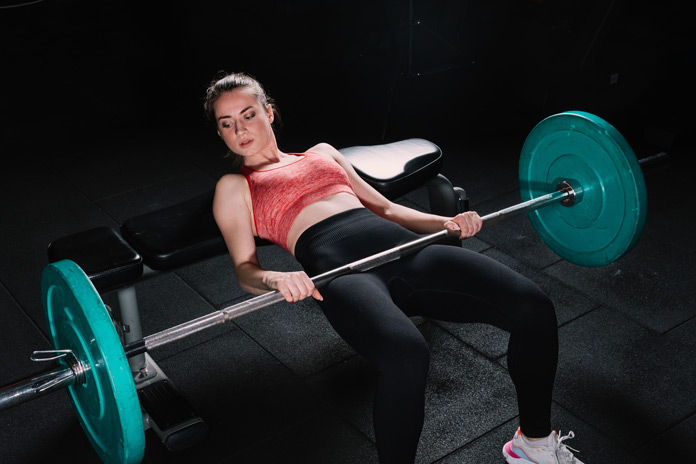
There are many variants, there are even specially designed fitness machines. In the following, we want to show you how to correctly perform the hip thrusts with the classic equipment of a fitness studio. In addition to a stable base, e.g. B. a weight bench you also need a weight. Let’s take a barbell for our case. You are also welcome to use padding for the dumbbell so that you can perform the exercise comfortably.
- You sit on the floor and lean your shoulder blades against the exercise bench. In the best case, the lower part of the shoulder blades is now on the edge of the weight bench. If this is not the case, you can easily slide a balance pad under your buttocks or later lift your buttocks slightly off the floor. Normally, 99% of athletes can do their exercises well with a bench height of 15-17 inches. If you want more stability, you can easily place the weight bench against a wall.
- Now you put the barbell down on your hip crease. The hands grip the barbell slightly wider than your shoulders so that you have a firm grip on the barbell during the exercise. Also, make sure you don’t pull your shoulders up towards your ears.
- The feet should be hip-width apart. Toes and knees point outwards. If you want more, you can also spread your feet wider. Try this if you want to feel your glutes more.
- Now it’s time for body tension! The bottom of the shoulder blades should still be at the bottom of the weight bench. Now push yourself up over your heels, stretching your hips toward the ceiling. You stretch your hips completely and your pelvis tilts backward. The gluteal muscle is now experiencing maximum contraction.
- Make sure your knees are directly over your feet in the top position. Your shins should now be perpendicular to the floor. Your head and neck are neutral. At the beginning of the exercise, the gaze is forward and during the exercise, the gaze is directed towards the ceiling.
- Finally, you lower the weight back down. Make sure your butt stays tight the whole time.
Common Hip Thrust Mistakes
One of the most common mistakes is the hollow back. In the top position of the exercise, the spine is hyperextended. Now here’s the problem: instead of engaging your butt muscles, you start straining your lower back and, worst-case scenario, you could end up with injuries. Therefore, make sure to always keep the tension in your buttocks to protect your lower back.
Here’s a little tip that simplifies the whole thing a bit: during the exercise, rest your chin on your chest and look forward instead of up. This will certainly make it easier for you to tilt your pelvis backward. And always think about your body tension!
Another mistake can be not pushing yourself up from your heels or even lifting your heel off the ground. In this case, your thighs would then have to work harder, which would then also relieve your buttocks and that is not the aim of the exercise. If it helps you, you can also lift your toes off the floor. This allows you to fully concentrate on your heels.
Another common mistake is insufficient hip extension. Don’t do things by halves here! Only when your hips are fully extended do your butt muscles work at their maximum. You must always keep in mind that your torso should be in a straight line down to your knees and should be parallel to the floor. If you’re having trouble fully extending your hips, decrease the weight here. It is better to have a properly executed exercise than to overdo it and possibly suffer injuries.
Different Variations Of Hip Thrusts For The Gym Or At Home
Above we described the classic barbell hip thrust. This exercise is great for the gym. But you can also do the hip thrust on the multi-press. The advantage here is that you don’t have to build up the set-up with the barbell first; you just add the bank here. But also keep in mind that the more freely you train – i.e. without equipment – the more muscles you stabilize during your movements. Result: The deep muscles are also claimed.
Do you prefer to train at home in your own home? No problem, we have a solution for you too! Just turn your couch into a weight bench and do the hip thrusts. And even if you don’t have any weights, this shouldn’t be an obstacle.
Single Leg Hip Thrust
You simply use your own bodyweight for this. The Single-Leg Hip Thrust is a real alternative to the classic exercises in the gym. You only do the single-leg hip thrust with one leg. Because only one leg has to support your entire body weight, this exercise is extremely intense and requires even more stability than the classic hip thrust variant. We would say give it a try and see how effective this exercise is!
The position is the same as for the classic hip thrust. Lean on your back, press your arms either bent against the bench or couch or stretch them out, and then lay them in a T-position on the couch/bench. Place your feet firmly on the floor, close together, and centered in front of you. Now raise one leg by pulling the knee towards your chest.
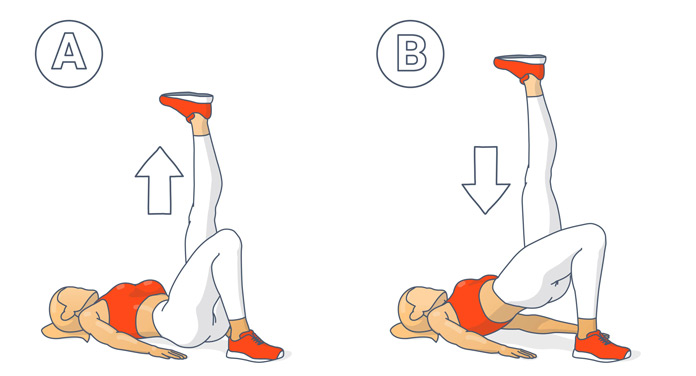
To do the exercise correctly, push off with your heel and make sure that your entire upper body down to your knees forms a line. Tighten your buttocks, exhale and lower back down. The exercise also works as a glute bridge variant.
Above all, you should always warm-up well before your workout! At least 10 minutes. To perform the exercise effectively, you should do 10 to 15 repetitions per leg for three sets. But don’t forget to rest for about 90 seconds between sessions.
Hip Thrust Versus Glute Bridge
You are probably familiar with the “glute bridge” exercise. It is also called a pelvic lift. But what is the difference between the glute bridge and the hip thrusts? Is one exercise better than the other? In a nutshell, the glute bridge is practically the “predecessor version” of the hip thrusts.
Here you lie with your upper body on a mat and put your legs on the bench. Now you lift your hips with the power of your heels. Your knees form a line up to your upper body again. In any case, you should start with the glute bridge before moving on to the hip thrusts.
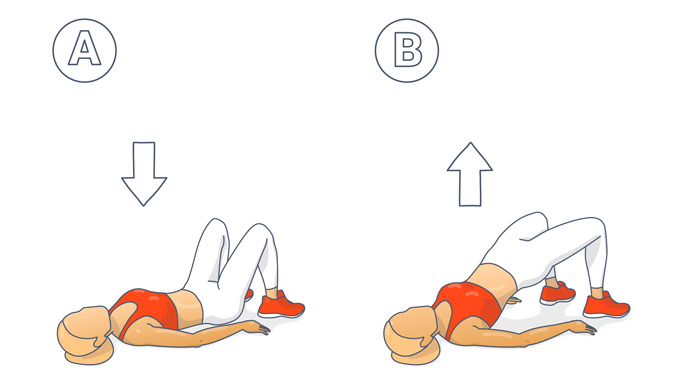
Of course, it is up to you to decide which exercise you ultimately choose. It certainly depends on your training status and equipment. Nevertheless, we recommend that you do both exercises so that you can add more variety to your workouts.

